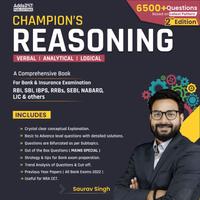Directions (1-3): In the following questions, the symbols @, #, %, $ and © are used with the following meaning as illustrated below-
‘P@Q’ means ‘P is neither greater than nor equal to Q’
‘P*Q’ means ‘P is neither equal to nor smaller than Q’
‘P$Q’ means ‘P is neither smaller than nor greater than Q’
‘P%Q’ means ‘P is not smaller than Q’
‘P#Q’ means ‘P is not greater than Q’
Now in each of the following questions assuming the given statement to be true, find which of the three conclusions I, II and III given below them is/are definitely true and give your answer accordingly.
Q1. Statements: F*G%H$I*J#K$L@M#N
Conclusions: I. F%I II. F$I III. M*I
(a) None is true
(b) Only I is true
(c) Only III is true
(d) Either I or II are true
(e) None of these
Q2. Statements: Y*T%O$J@P*X%Z
Conclusions: I. O@P II. T * X III. J#T
(a) Only I and III are true
(b) Only II and III are true
(c) Only I and II are true
(d) All are true
(e) None of these
Q3. Statements: L $ P, P * U, U @ M, Y * U
Conclusions: I. L * Y II. U @ L III.Y * L
(a) None is true
(b) Only II is true
(c) Only I and II are true
(d) Only II and III are true
(e) All are true
Q4. Which of the following symbols should replace the sign (@) and (%) respectively in the given expression in order to make the expression E ≥ T and S> A definitely true?
E ≥ I ≥ R = W = A @ T ≤ W % S
(a) =, <
(b) ≥, <
(c) >, ≤
(d) ≤, =
(e) ≤, ≤
Q5. Which of the following will be definitely true if the given expression E=R<V>S>M=O>X=Y>T is definitely true?
(a) V < T
(b) X > E
(c) R > M
(d) Y ≥ R
(e) Y < V
Solutions
Solutions (1-3):
S1. Ans. (a)
Sol. I. F%I(False) II. F$I (False) III. M*I (False)
S2. Ans. (a)
Sol. I. O@P(True) II. T * X (False) III. J#T (True)
S3. Ans. (b)
Sol. I. L * Y (False) II. U @ L (True) III.Y * L (False)
S4. Ans. (a)
S5. Ans. (e)
. .





 GA Capsule for SBI Clerk Mains 2025, Dow...
GA Capsule for SBI Clerk Mains 2025, Dow...
 The Hindu Review October 2022: Download ...
The Hindu Review October 2022: Download ...
 RBI Grade B Previous Year Question Paper...
RBI Grade B Previous Year Question Paper...





